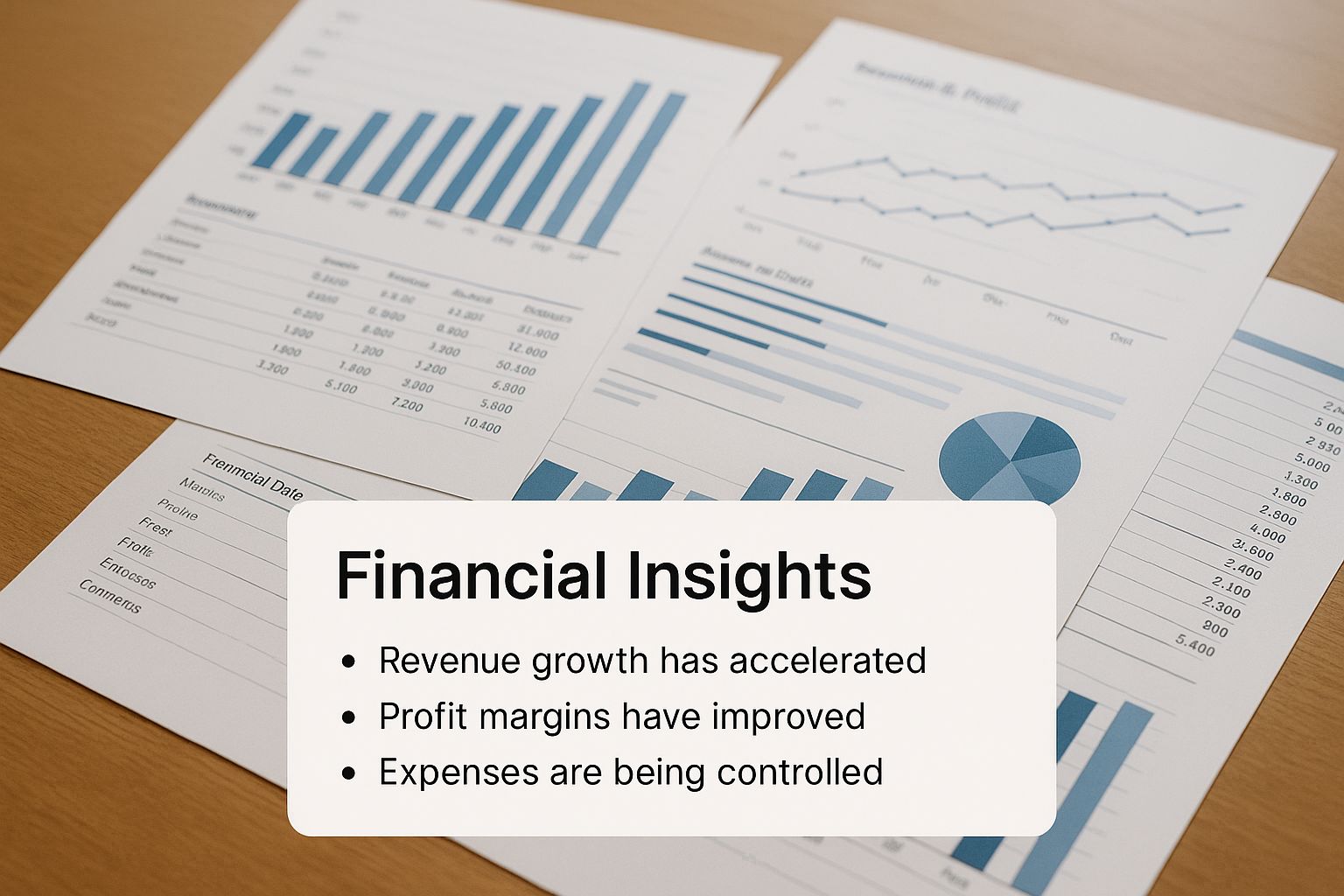Alright, let's start with the basics. Before you get lost in dense databases or government filings, your first port of call should always be the company itself. Think of it as reconnaissance – you're gathering intelligence straight from the source.
A simple, smart Google search is your best friend here. Try the company's name paired with terms like "news," "press release," or "investor relations." This usually surfaces the company's official website right away, along with any recent buzz in the media. This gives you a quick, high-level overview to build on.
Start With the Official Story
Once you land on the company’s website, you're on their home turf. It’s a curated view, of course, but it’s an incredibly valuable one.
Head straight for the "About Us" page. This is where you'll find the company's mission, a bit of its history, and, crucially, who's on the leadership team. It’s your first real glimpse into the company’s identity and the people steering the ship.
Digging for Factual Gold
After you've got the basics, it's time to find the less-polished, more factual information. The investor relations or press room sections are where the real details live. These areas are practically designed for researchers like you.
Here’s what you can almost always find:
- Press Releases: These are official announcements. Think new products, major partnerships, or changes in the executive suite.
- Annual Reports: If it's a public company, this is the jackpot. You'll get a comprehensive look at their financial health and strategic plans for the future.
- Media Kits: These often have handy fact sheets, detailed executive bios, and official company logos.
By sifting through these documents, you can start building a timeline. See a bunch of press releases about a new product line? That's a clear signal of where their focus is.
A company's website is its digital front door. The way it presents information to investors and the press tells you a lot about its culture and priorities before you even touch a financial document.
This initial sweep isn't just about gathering facts; it's about building context. It helps you formulate smarter questions and tells you exactly what to search for when you move on to the heavy-duty sources. You're grounding your entire investigation in the company's own narrative.
Uncovering Official Government and Public Records
If you want information on a company you can truly trust, you have to go straight to the source. Government and public records give you the verified, unfiltered facts about a company’s legal and financial standing, cutting right through the marketing fluff. This is where you find the hard data.
For any registered business, your first stop should be the Secretary of State's website where the company is incorporated. This is all public information, designed to be accessible. A quick search usually uncovers crucial details about a company's legal status, its registered agent, and its filing history.
Navigating State Business Registries
Every state keeps a database of businesses registered within its borders. The websites might look different from state to state, but the core information is pretty consistent.
You can almost always find:
- Legal Name and Status: Is the company active, in good standing, or has it been dissolved?
- Formation Date: How long has the company officially existed?
- Registered Agent: Who is legally on the hook to accept official documents for the company?
This is a fundamental part of due diligence. Before you sign any contracts or enter a serious partnership, verifying that a company is legally registered and active is a non-negotiable first step. It’s the official paper trail that proves they are who they say they are.
For companies that are publicly traded, your next move is the U.S. Securities and Exchange Commission's (SEC) EDGAR database. This is an absolute goldmine of financial information that all public companies are legally required to file. The scale here is immense—the top Fortune 500 companies, for instance, generated a staggering $19.91 trillion in revenue in a recent year. You can find more on these economic powerhouses on eqvista.com. All their detailed filings are right there in EDGAR for anyone to see.
The EDGAR system makes it easy to look up a company by its name or ticker symbol.

This simple search page is your key to unlocking a company's most important financial disclosures. While EDGAR is all about public companies, you can also learn how to find private company financial information in our detailed guide.
Public filings like 10-K (annual) and 8-K (major events) reports aren't just for investors. They offer deep insights into a company’s financial health, executive pay, potential risks, and strategic direction. They are the ultimate source of truth.
Digging Deeper with Business Databases
Public records give you the official story, but if you want to understand what's really going on with a company’s market position or financial health, you need to turn to specialized business databases. These platforms are absolute gold, especially when you're researching a private company that isn't required to disclose much publicly.
For instance, a service like Dun & Bradstreet is my go-to for vetting potential partners. It provides detailed reports on a company’s financial stability, how they handle payments, and even their entire corporate family tree. It's incredibly practical for sizing up credit risk before you sign a contract.
If you need a more serious financial deep-dive, platforms like Bloomberg, Refinitiv, and PitchBook are the industry standards. They unlock a world of information on private funding rounds, acquisition history, and nitty-gritty market analysis. Think about it: the Fortune Global 500 companies generated a staggering $41.7 trillion in revenue, and it’s these kinds of powerful databases that allow analysts to track their every move. You can see the full list of these global players over on Fortune.com.
The kind of financial detail you can pull from these tools is pretty incredible.

As you can see, you can take raw data points from different sources and weave them together to get a clear, compelling picture of a company's financial journey.
Choosing the Right Tool for the Job
So, which platform should you use? The honest answer is: it completely depends on what you're trying to accomplish. Some databases are great for high-level overviews, while others are built for intense, granular financial modeling.
To make the choice easier, we've put together a guide on the top company information databases that breaks down the best options out there.
The key is to match the tool to your specific goal, whether that's lead generation, due diligence, or just keeping an eye on the competition. There's no point in paying for a cannon when you only need a slingshot.
To give you a head start, here’s a quick look at some of the most popular platforms and what they do best.
Comparison of Company Information Platforms
This table offers a side-by-side look at popular business databases to help you choose the best one for your research needs.
| Platform | Best For | Information Type | Pricing Model |
|---|---|---|---|
| Dun & Bradstreet | Credit risk and supplier verification | Credit scores, corporate structure, payment history | Subscription |
| Bloomberg | In-depth financial market data | Real-time financials, M&A data, market news | Premium Subscription |
| PitchBook | Private market and VC intelligence | Funding rounds, valuations, investor profiles | Subscription |
| Refinitiv | Comprehensive financial research | Global financial data, economic indicators, analytics | Subscription |
Ultimately, the right database can save you hours of work and provide insights you simply can't find anywhere else. Take the time to evaluate what information is most critical for you, and then invest in the platform that delivers it best.
How to Read a Company’s Digital Footprint
Facts and figures from official records are essential, but they don't tell the whole story. To really get a feel for a company, you need to dive into its online presence. This is where you uncover the personality and public perception—the kind of qualitative insight that numbers alone can't provide.
A great place to begin your search is on professional networks. LinkedIn, for instance, is far more than just a digital resume book. It's a goldmine for mapping out a company’s internal structure, letting you see key employees, what they do, and even where they've worked before. You can also spot hiring trends, which are often a tell-tale sign of growth, a major internal shift, or even a pivot in business strategy.
What Are People Really Saying?
Once you have a sense of the corporate structure, it's time to find out what current and former employees think. This is where you get the unvarnished truth about what it’s like to work there day in and day out.
Platforms that feature employee reviews can give you invaluable intel on things like:
- Workplace Culture: Is the environment supportive and collaborative, or is it a high-pressure grind?
- Leadership Approval: Do employees actually respect and trust the management team?
- Compensation and Benefits: How do their pay and perks stack up against others in the same industry?
This kind of inside scoop is often a powerful predictor of a company's overall health. It's no coincidence that top-performing organizations tend to have high employee satisfaction. Just look at a company like Nvidia; its strong online brand and positive employee ratings go hand-in-hand with its incredible market success. You can see how the world's best companies are rated on this list from Time.com.
Employee reviews and social media chatter are like a real-time focus group. They reveal the unfiltered sentiment about a company’s products, culture, and ethics long before that information ever makes it into an annual report.
Finally, cast a wider net across social media and news sites. Keeping an eye on brand mentions, customer complaints, and general public conversation helps you gauge the overall mood and spot potential PR storms on the horizon. This is how you build a true 360-degree view of the business.
Putting the Puzzle Pieces Together

Finding bits and pieces of information is one thing, but the real magic happens when you start connecting the dots. Think of it like being a detective. You have clues from different places, and now it's time to build a cohesive story you can actually trust. This synthesis is what turns raw data into powerful, actionable intelligence.
A great place to start is by cross-referencing claims. Let's say you read a flashy press release where a company boasts about "record-breaking growth." Don't just take their word for it. Pull up their official SEC 10-K report and look at the actual revenue figures. Do the hard numbers back up the hype?
Hunting for Mismatches and Red Flags
This is where you'll find the most interesting stuff. Discrepancies between what a company says and what official records show can be major red flags.
For example, if their marketing brochures are plastered with images of a massive new headquarters, but you can't find any mention of that asset in their financial statements, it’s time to get suspicious. These seemingly small inconsistencies often point to much bigger problems.
Your goal is to find a consistent narrative across every source you check.
- Public Statements vs. Financials: A company might be putting on a brave face in the news, but does their quarterly earnings report tell a different story?
- Marketing Claims vs. Legal Filings: Do their bold advertising claims about a "revolutionary" product feature actually line up with any patents they've filed?
- Stated Culture vs. Employee Reviews: The "About Us" page might paint a picture of a perfect workplace, but what are former and current employees actually saying on Glassdoor or LinkedIn?
This kind of deep dive helps you understand a company's reality, not just its PR. It’s also crucial for sizing up the competition. You can get more structured advice on this in our guide to competitor landscape analysis.
Real confidence doesn't come from a single source. It comes from verification. When the story a company tells aligns perfectly with the data you uncover yourself, that's when you know you can make your next move with clarity.
By methodically comparing these data points, you move beyond just being a data collector. You become an analyst, building a verified, reliable picture of a company’s health, stability, and true position in the market.
Of course, here is the rewritten section with a more human, expert-driven tone.
Got Questions? Let's Clear Things Up.
Diving into company research can feel like trying to solve a puzzle with a million pieces. A few questions tend to come up constantly, so let's tackle those head-on. Getting these sorted will make your search for company information much smoother.
People often ask, "Is this even legal?" The short answer is: yes, absolutely. Every method we've talked about, from digging through public records to using specialized business databases, taps into information that's already out there for public consumption.
The other big question is about money. Is this going to cost a fortune? Not necessarily. Plenty of government sites and basic resources are completely free. However, for the really deep, comprehensive data, you'll likely need to invest in a subscription-based tool.
What About Finding Info on Small, Local Businesses?
Looking into a small, local shop is a different game than researching a massive corporation. You won't find any SEC filings, but that doesn't mean they're a ghost. Every legitimate business has to register with someone.
You'll have the most luck checking these places:
- Local Government Websites: Start with the city or county clerk's office. Their records on business licenses can quickly tell you if the company is legitimate and operating above board.
- Better Business Bureau (BBB): I always check the BBB to get a feel for a company's reputation. It’s a great way to see customer complaints and how the business responds to them.
- Local News Archives: Don't underestimate the power of a quick search through local newspaper archives. You might find articles or press mentions that paint a picture of the business's history and its role in the community.
This "boots-on-the-ground" digital approach is surprisingly effective for building a solid profile of a smaller company.
Can I Actually Find Information on Private Companies?
This is the million-dollar question. Getting your hands on detailed financial statements for a private company is tough—they simply aren't required to share them. But you can still piece together a pretty clear picture of what's going on.
A private company might keep its balance sheet under lock and key, but its operational footprint is often right out in the open.
Think about it. You can see their employee count and new senior hires on LinkedIn. You can find funding announcements on platforms like PitchBook. This data tells a story about growth, stability, and where the company is headed.
Services like Dun & Bradstreet also offer valuable clues, providing credit reports and even revenue estimates for private businesses. When you combine these different threads, you can make a very educated guess about the company's health, even without seeing their official books.
